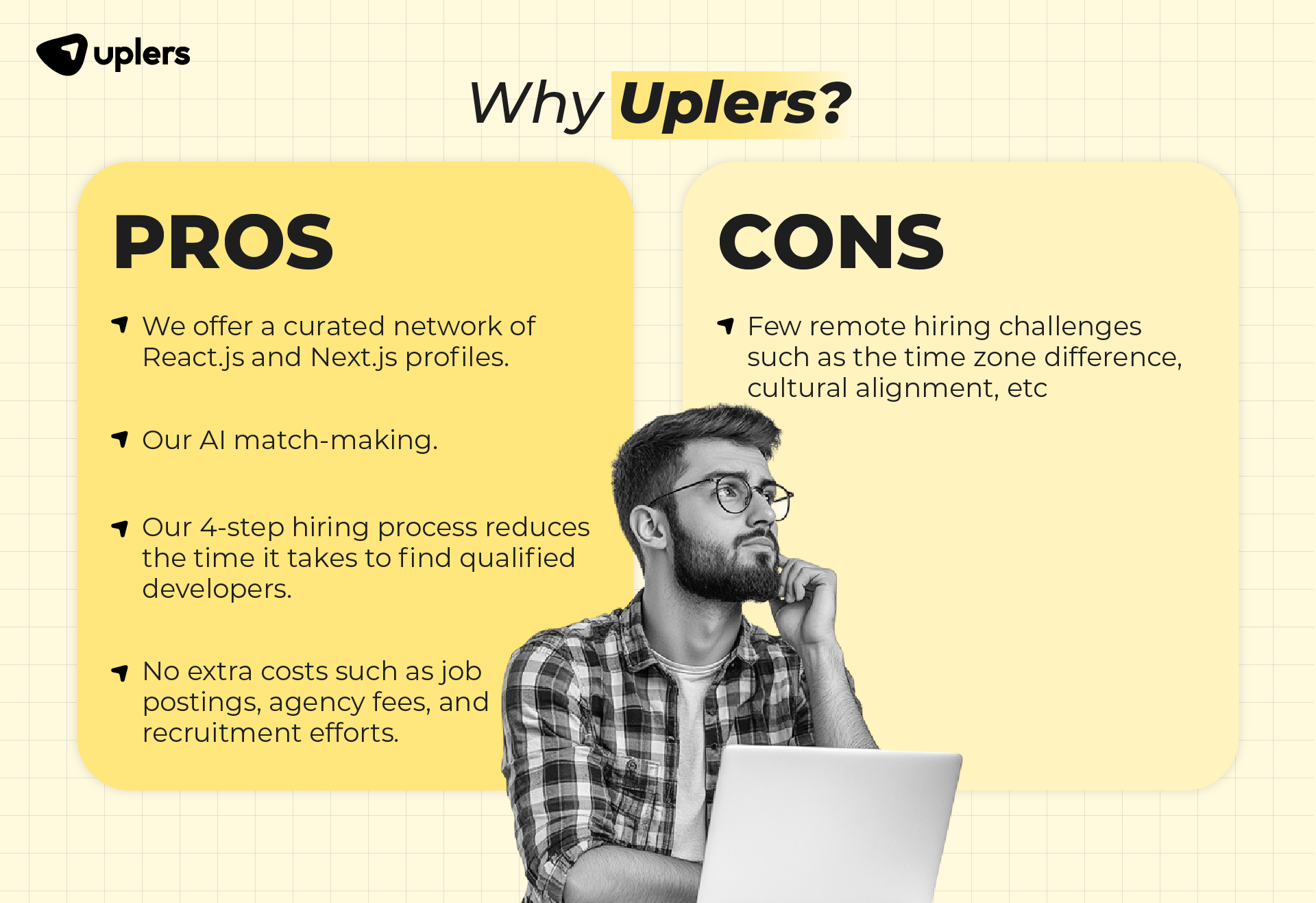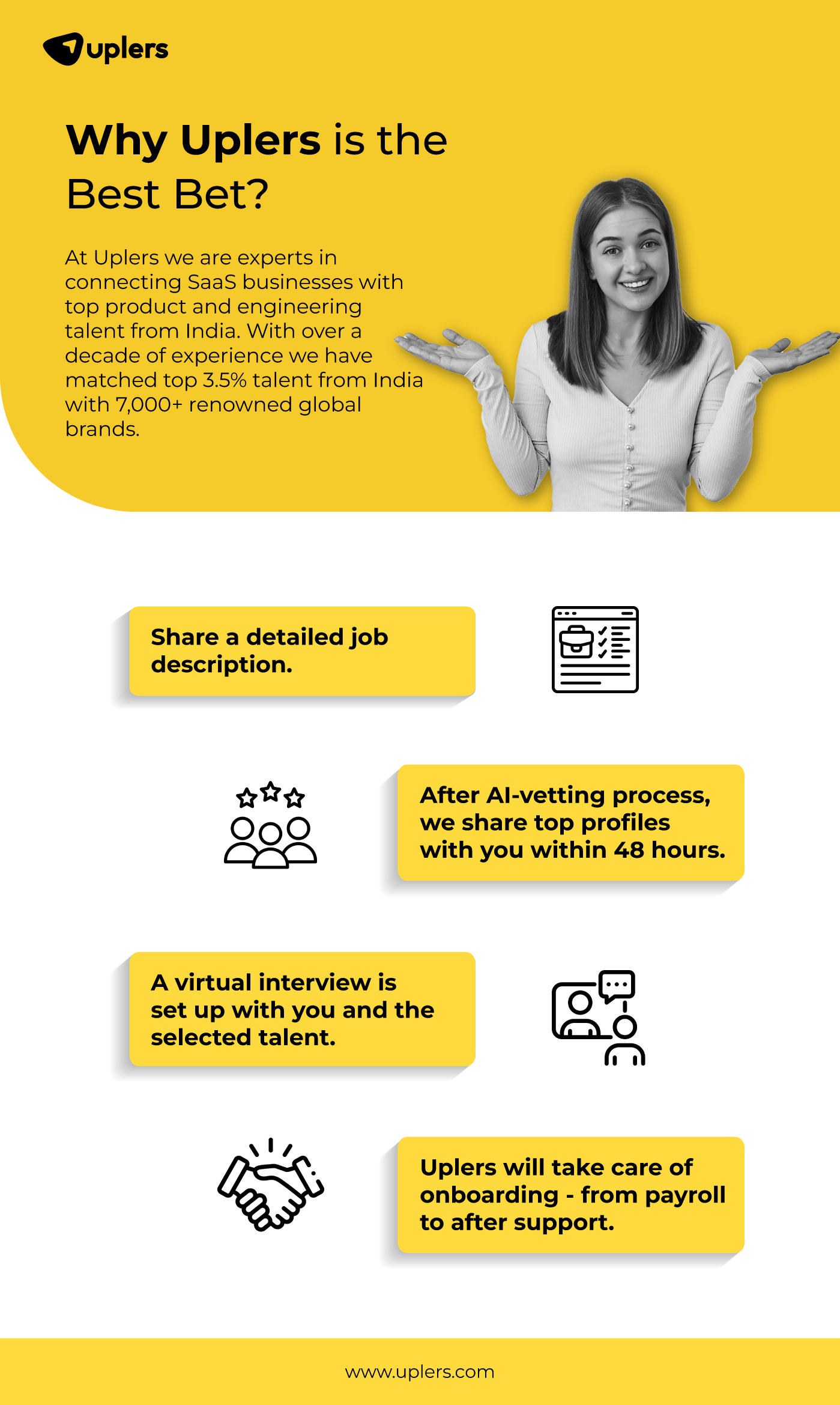The evolution in the web development landscape is at a breakneck speed and it’s no hidden reality. Choosing the right technology stack becomes crucial especially when you are considering front-end development and there is a list of the top frameworks for front-end development.
Amongst these the 2 frameworks that are constantly dominating the landscape are React.js and Next.js. Both are powerful tools but to understand their nuances is vital when you are considering developing scalable, performant, and user-friendly web applications. The debate of React.js vs. Next.js is not simply about which is inherently better, but more about which one suits better for your specific project needs. As a SaaS company this decision can have a significant bearing on the development speed, performance, SEO, and overall cost.
In this article we will dive deep into each framework to explore the differences and help you determine which specialization will be more beneficial for your project.
What is React.js?
React.js is regarded as a declarative, efficient, and flexible JavaScript library for developing user interfaces. It lets you build complex user interfaces from small and isolated code pieces called “components”. It’s not a full-fledged framework but a library that is solely focused on the view layer of an application.
Core features and functionalities
React’s core lies in its component-based architecture, virtual DOM, and JSX syntax. The component-based architecture allows developers to break down UIs into reusable components, promoting code reusability and maintenance. The virtual DOM helps in performance optimization by minimizing direct manipulations to the real DOM.
Additionally, JSX serves as a valuable extension to JavaScript allowing developers to write HTML-like code within JavaScript. This makes UI development more intuitive with faster rendering.
Use cases and industries where React.js excels
The need to hire dedicated React.js developers is prominent across a vast spectrum of industries from e-commerce to social media and content management systems. The component-based architecture and fast rendering potential make it an ideal pick for interactive and dynamic UI development. It’s a well-suited fit for single-page applications where performance and user experience hold an upper hand.
Companies using React.js
Several reputed companies have and are still leveraging React.js to power their web applications. Facebook, Instagram, Airbnb, and Yahoo are just a few examples. These companies trust React’s scalability, performance, and flexibility in rendering exceptional user experiences to millions of users globally.
It should come as no surprise that Facebook, the creator of React, utilizes it extensively across its platform.
What is Next.js?
Next.js is an open-source React framework enabling functionalities such as server-side rendering and static website generation for React-based web applications. It’s built on top of Node.js and allows React-based web applications to be rendered from the server-side instead of rendering all content in the browser.
Core features and functionalities
Next.js enhances React with server-side rendering (SSR), static site generation (SSG), file-system routing, and API routes. SSR improves SEO and initial load time by rendering pages on the server before sending them to the client. SSG allows you to pre-render the pages at build time, resulting in an extremely fast loading time. The file-system routing system simplifies the route creation, while API routes enable you to build backend functionalities directly within your Next.js application.
Advantages over traditional React.js applications
Next.js offers several advantages over traditional React.js applications. Some of these include:
- Server side rendering significantly improves SEO by making it easier for search engines to crawl and index your website.
- Static site generation helps deliver unmatched performance by pre-rendering ages at build time.
- Built-in routing simplifies the development process and eliminates the need for external routing libraries.
- Companies using Next.js
Several companies utilize Next.js, including Netflix, TikTok, Starbucks, and Uber. These companies leverage the performance and SEO potential of Next.js to power its landing pages, while TikTok uses it to improve its website performance and SEO.
Key Differences Between React.js and Next.js
The core difference between React.js vs. Next.js lies in their nature. React is a library focused on UI rendering, while Next.js serves as a full-fledged framework built upon React, offering features like routing, server-side rendering, and API handling out-of-the-box.
Let’s compare them on the following grounds:
Focus Area | React.js | Next.js |
Architecture and Framework Comparison | It’s primarily a library that is focused on UI components. When you hire dedicated React.js developers they need to choose and integrate additional libraries for routing and data fetching. | It’s a framework that is built on React, providing built-in solutions for routing, API endpoints, and data fetching. It offers a more structured and opinionated development approach. |
Performance differences | It can result in slower initial load times due to client-side rendering, where the browser downloads and executes all JavaScript before rendering the UI. | On grounds of React.js vs. Next.js performance, the latter holds prominence. Thanks for the server-side rendering and static site generation resulting in agile load time. However, subsequent client-side interactions can be slightly slower. |
SEO capabilities: Client-side vs. Server-side rendering | Significant efforts and configuration is required to optimize for search engines. Search engines often face challenges in properly indexing content that is rendered on the client-side. | It’s optimized for SEO out-of-the-box because content is rendered on the server or during build time. This makes it readily indexable by search engines which is yet crucial for your SaaS company. |
Development complexity and learning curve | It has a low learning curve initially due to small scope. | Higher learning curve due to the framework’s more comprehensive feature set and conventions. |
Scalability and maintenance | Highly scalable when following best practices for component design and state management. Well-maintained with a large and active community. | Highly scalable with features like API routes and serverless functions. Well-maintained with a growing community, benefiting from Vercel’s support. |
When to Choose React.js?
When you require a dynamic and interactive user interface without the emergency of SEO optimization or server-side rendering, React.js can shine bright.
Best scenarios for using React.js
React.js is an excellent choice over other frameworks for building single-page applications, interactive dashboards, and user interfaces for web and mobile applications. It’s also a good choice when you need a highly customizable and flexible solution.
Ideal project types and business cases
React.js is ideally suited for projects where performance and user experience hold supremacy. It’s also a good choice for building internal tools and dashboards where SEO is not of primary concern. For instance, React could be a great fit when considering building a complex UI with a lot of dynamic data updates for a customer service portal.
When to Choose Next.js?
Amongst React.js vs. Next.js, Next.js can be your hero when SEO, performance, and a comprehensive development experience are your top concerns.
Best scenarios for using Next.js
Next.js is an ideal choice for building e-commerce websites, blogs, marketing websites, and other content-heavy applications where SEO is superior. It’s also a good choice for server-side rendered applications and static websites.
Ideal project types and business cases
Next.js is perfect for projects that need excellent SEO, agile load times, and a seamless user experience. E-commerce websites, news portals, and marketing websites are all excellent candidates for Next.js. If you as a SaaS company are building a new website that needs to rank well in SERP, it can greatly benefit from Next.js’s SEO capabilities.
Hiring Considerations: React.js vs. Next.js Developers
Deciding whether to hire Next.js developers or React.js talent depends on several factors such as project requirements, budget, and others stated below:
Skills required for each framework
When evaluating React.js developer skills, they must possess a strong understanding of JavaScript, HTML, CSS, and React concepts like components, state management, and JSX. A Next.js developer on the other hand should have all skills of a React.js developer, plus knowledge of server-side rendering, static-site generation, and API routes.
Cost comparison: Hiring a React.js developer vs. a Next.js developer
Generally, Next.js developers command higher salaries compared to the cost of hiring React.js developers, due to their additional skills and experience. However, the long-term benefits of Next.js such as improved SEO and performance can justify the increased cost.
Availability of talent in the job market
The availability of React.js developers is generally higher than Next.js developers due to the popularity and maturity of React.js. However, the demand for Next.js developers is rapidly growing, reflecting the increasing adoption of Next.js.
Why Uplers? Pros and Cons

Uplers as the largest end-to-end AI hiring platform streamlines hiring for SaaS leaders seeking top product and engineering talent from India. We offer access to a pre-vetted talent network of 1.5M + professionals. Wondering that would take up your time and efforts 2X?
That’s not true! We use a judicious balance of artificial intelligence and human evaluation to give you the best 3.5% profiles. This will reduce the time and effort involved in the traditional hiring process, and at the same time save you up to 40% on hiring costs without compromising on quality. Top talent at a fair price, isn’t that a win-win kind of situation?
Let’s help you better evaluate our platform based on a list of the pros and cons:
Pros:
- We offer a curated network of React.js and Next.js profiles from India to save you the hassle of initial sourcing, screening, and vetting.
- Our AI algorithms analyze your project requirements and match the most suitable talent profiles ensuring a high degree of fit.
- Our streamlined 4-step hiring process significantly reduces the time it takes to find and hire qualified developers. This helps you accelerate your project timeline.
- By leveraging our hiring platform you can avoid the costs associated with traditional recruitment methods such as job postings, agency fees, and internal recruitment efforts.
Cons:
Unlike every other alternative and player in the industry we also have some potential areas of improvement such as:
- While we offer an extensive talent network, you will have to overcome a few remote hiring challenges such as the time zone difference, cultural alignment, etc. But nothing is a rocket science if you have the right strategies to mitigate them.
We aim to be a valuable partner in your journey of finding the top talent from India for your product company. While we have significant advantages to ease hiring for you, you must carefully evaluate the pros and cons before making a decision.
Future Trends: React.js and Next.js in 2025 and Beyond
The future for React.js as well as Next.js looks promising considering the following growth projections and evolving trends:
Growth projections and adoption trends
Both React.js and Next.js are expected to continue their growth trajectory in the coming future. React.js will remain a dominant force in front-end development, while Next.js will gain increasing traction as more developers embrace server-side rendering and static site generation.
According to Statista, React.js is among the most popular JavaScript frameworks used by developers worldwide.
Emerging technologies influencing React.js and Next.js development
Emerging technologies such as WebAssembly, serverless computing, and AI-powered development tools are expected to further enhance the capabilities of React.js and Next.js.
WebAssembly will enable faster and efficient client-side performance, while serverless computing is expected to simplify development and scaling. AI-powered tools will automate repetitive tasks and enhance the code quality.
Which One Should Your Developer Specialize In?
Finally, in choosing between React.js vs. Next.js, the choice depends entirely on your project’s specific needs. While React.js is ideal for dynamic UIs and SPAs, Next.js is perfect for SEO-optimized websites and applications using server-side rendering.
If your project prioritizes SEO performance and a comprehensive development experience, Next.js is the clear winner. For a highly customizable and flexible solution to build interactive UIs, React.js is a wise choice. The best approach could also be to have developers who are proficient in both React.js and Next.js, to let you choose the right tool depending on your project needs.














